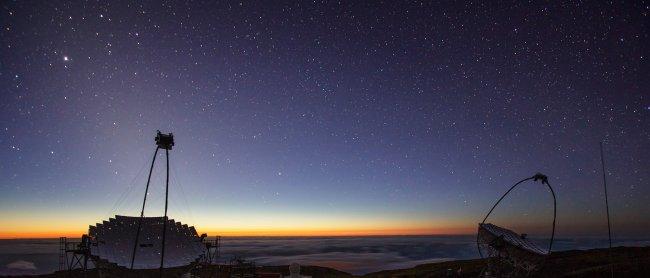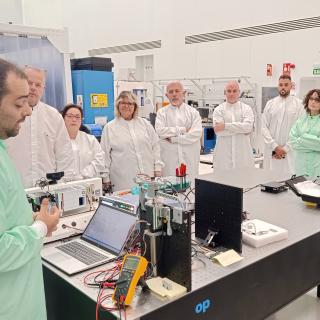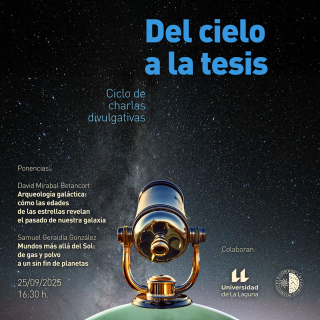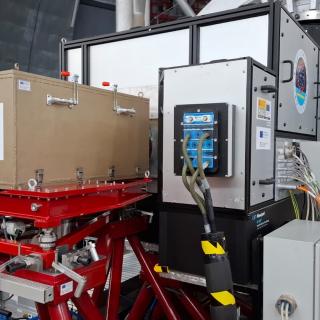The MAGIC (Major Atmospheric Gamma Imaging Cherenkov telescope) collaboration will be 15 years old and they will celebrate in La Palma, between June 26th and 29th, with a scientific conference, a ceremony, and some open days dedicated to public outreach. The aim is to publicize the scientific and technical achievements reached in the study of high energy physics thanks to the work of the two Cherenkov Telescopes MAGIC-I and MAGIC-II, at the Roque de los Muchachos Observatory (ORM).
The Spanish astronomical community has participated in MAGIC from the start, represented by the public research centres: el Institute of Astrophysics of the Canaries (IAC), the Institute of High Energy Physics (IFAE) , the Autonomous University of Barcelona (UAB), and the Complutense University of Madrid (UCM). In addition the data centre for MAGIC is the Portal for Scientific Information (PIC) a collaboration between the IFAE and the Centre for Research in Energy, the Environment, and Technology (CIEMAT).
The conference will bring together around one hundred specialists from the international MAGIC collaboration, which comprises 24 institutions in 11 coujntries, and scientists from all over the world. There will be over thirty oral papers divided into eight sessions which will deal with subjects such as cosmic rays, gamma rays, cosmology, neutrinos, gravitational waves, and so called “multi-messenger astronomy”. The opening ceremony of the meeting will be held on Wednesday June 27th at 09:30 in the H10 Hotel Taburiente Playa, Santa Cruz de La Palma, in the presence of the Director of the IAC Rafael Rebolo, and the spokesman for the MAGIC collaboration from the Max Planck Institute of Physics in Munich, Razmik Mirzoyan.
The ceremony to celebrate the 15th anniversary of MAGIC will take place on Thursday 28th June at 15:30 in the area of the MAGIC-I telescope at the ORM. This will last for half an bour, and the main people in charge of the international consortium which runs MAGIC will take part.
Outreach days
There will be two events of outreach in Santa Cruz de La Palma in parallel with the conference. On June 27th at 19:00 in the Salazar Palace, the IFAE reserach Juan Cortina will give a public lecture entitled “MAGIC: seeing invisible light”. In this talk he will explain how the MAGIC telescopes can see the most energetic light in the universe, the gamma rays, and how their study reveals a violent universo in permanent flux.
On Thursday June 28th at 20:00 in the Casa Tey cafetería in the capital of La Palma there will be a second outreach session, called “Pint of Magic” in which three young researchers who are working in the MAGIC collaboration will explain in a clear and entertaining way, various aspects of high energy physics, while the public enjoy a drink.
Participating in this activity will be : Camilla Maggio, an Italian researcher at the UAB, who will talk about the secrets which light, and in particular gamma rays, reveal to us; Jezabel Rodríguez García, a Canarian researcher at the Max Planck Institute in Munich, and the IAC, will explain how the study of gamma rays is helping us to understand questions such as dark matter, the active nuclei of galaxies, pulsars, and binary stars; and Victor Acciari, a MAGIC researcher working in La Palma, who will comment on his day to day work with the Cherenkov telescopes.
Cherenkov Telescopes
MAGIC is a scientific installation made up of two Cherenkov telescopes, each of 17 diameter, for the observation of high energy gamma rays produced, in general, by very violent astrophysical phenomena such as supernovae and active galactic nuclei. When this type of radiation hits the top of the atmosphere it generates a shower of particles, which travel faster than the velocity of light in air. This shower of particles emits a burst of light which lasts no longer than a thousand millionth of a second ( a nanosecond), which is called “Cherenkov light”. The MAGIC telescopes can capture this type of radiation efficiently, because, thanks to the large size of their mirrors, they can pick up this light even though it is spread out, and can focus it onto a highly sensitive detector.
The Observatories of the Instituto de Astrofísica de Canarias (IAC) are a part of the network of Singular Scientific and Technical Infrastructures (ICTS) of Spain.
IMPORTANT
If you wish to cover the celebration ceremony on Thursday 28th June at the ORM we request that you confirm your attendance at prensa [at] iac.es (prensa[at]iac[dot]es)
More information about the Conference and the ceremony:
https://indico.mpp.mpg.de/event/5698/other-view?view=standard
More information about the Outreach Days:
https://www.facebook.com/events/171716260330285/



